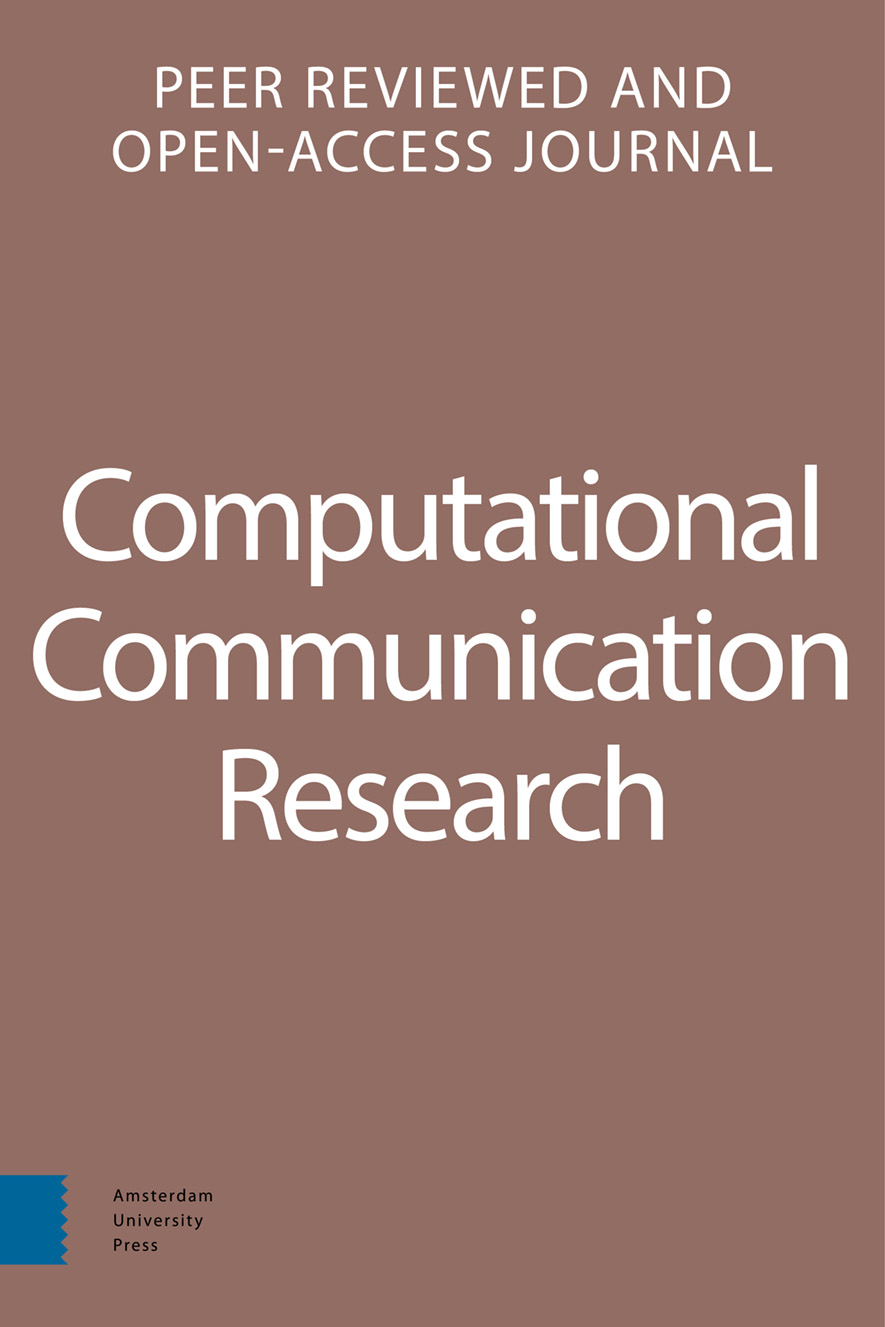- Home
- A-Z Publications
- Computational Communication Research
- Previous Issues
- Volume 5, Issue 2, 2023
Computational Communication Research - Volume 5, Issue 2, 2023
Volume 5, Issue 2, 2023
Language:
English
-
-
C-MFD 2.0: Developing a Chinese Moral Foundation Dictionary
More LessAuthors: Calvin Yixiang Cheng & Weiyu ZhangOur paper describes the development of a Chinese Moral Foundation Dictionary (C- MFD 2.0) to assist the automated detection and analysis of moral intuition in the Chinese context. Taking the approach of method-theory co-development, we follow a human-led and machine-assisted procedure that emphasizes opportunities for theoretical advancement, which enhances the validity of the computational tool. Starting fr Read More
-
-
-
Validating a Mixed-Method Approach for Multilingual News Framing Analysis: A case study of COVID-19
More LessAuthors: Gulsah Akcakir, Yanru Jiang, Jun Luo & Seonhye NohA reliable multilingual news framing analysis can shed light on the similarities and dissimilarities of journalistic practices across geographical areas and cultures, facilitating comparative studies in media discourse and framing analysis. However, there is an insufficient supply of standardizing and validating computational approaches for multilingual text analysis. To fill the gap, this study validates a multi-stage mixed-method appro Read More
-
-
-
Going cross-lingual: A guide to multilingual text analysis
More LessAuthors: Hauke Licht & Fabienne LindText-as-data methods have revolutionized the study of political behavior and communication, and the increasing availability of multilingual text collections promises exciting new applications of these methods in comparative research. To encourage researchers to seize these opportunities, we provide a guide to multilingual quantitative text analysis. Responding to the unique challenges research faces in multilingual analysis, Read More
-
-
-
Evaluating Transferability in Multilingual Text Analyses
More LessAuthors: Justin Chun-ting Ho & Chung-hong ChanMultilingual text analysis is increasingly important to address the current narrow focus of English and other Indo-European languages in comparative studies. However, there has been a lack of a comprehensive approach to evaluate the validity of multilingual text analytic methods across different language contexts. To address this issue, we propose that the validity of multilingual text analysis should be studied thro Read More
-
-
-
URLs Can Facilitate Machine Learning Classification of News Stories Across Languages and Contexts
More LessAuthors: Ernesto de León, Susan Vermeer & Damian TrillingComparative scholars studying political news content at scale face the challenge of addressing multiple languages. While many train individual supervised machine learning classifiers for each language, this is a costly and time-consuming process. We propose that instead of relying on thematic labels generated by manual coding, researchers can use ‘distant’ labels created by cues in article URLs. Sections reflected in U Read More
-
-
-
Selecting Relevant Documents for Multilingual Content Analysis: An Evaluation of Keyword and Semantic Similarity Search Approaches
More LessAuthors: Sean Palicki, Stefanie Walter, Wouter van Atteveldt, Alice Beazer & Isaac BravoComparative research in communication often involves selecting and analyzing documents in multiple languages. Machine translation is an effective pre-processing step for automated content analysis, however its impact on data collection remains under-examined. Using a parallel language corpus of European Parliament debates, this paper evaluates machine translation as an approach for multilingual document r Read More
-
-
-
Machine Translation as an Underrated Ingredient? Solving Classification Tasks with Large Language Models for Comparative Research
More LessAuthors: Akos Mate, Miklós Sebők, Lukasz Wordliczek, Dariusz Stolicki & Ádám FeldmannWhile large language models have revolutionised computational text analysis methods, the field is still tilted towards English language resources. Even as there are pre-trained models for some smaller languages, the coverage is far from universal, and pre-training large language models is an expensive and complicated task. This uneven language coverage limits comparative social research in terms of its geographical and ling Read More
-
-
-
Lowering the Language Barrier: Investigating Deep Transfer Learning and Machine Translation for Multilingual Analyses of Political Texts
More LessAuthors: Moritz Laurer, Wouter van Atteveldt, Andreu Casas & Kasper WelbersThe social science toolkit for computational text analysis is still very much in the making. We know surprisingly little about how to produce valid insights from large amounts of multilingual texts for comparative social science research. In this paper, we test several recent innovations from deep transfer learning to help advance the computational toolkit for social science research in multilingual settings. We investigate the e Read More
-
-
-
Word-level machine translation for bag-of-words text analysis: Cheap, fast, and surprisingly good
More LessThe quality of automated machine translation is rapidly approaching that of professional human translation. However, the best methods remain costly in terms of money, computational resources, and/or time, particularly when applied to large volumes of text. In contrast, word-level translation is both free and fast, simply mapping each word in a source language deterministically to a target language. This paper dem Read More
-
-
-
Back to the basics: Applying multilingual dictionary analysis to the Comparative Manifesto Project corpus
More LessBy Joshua CovaFor researchers interested in political communication and electoral politics, the Comparative Manifesto Project (CMP) is a widely-used database, which contains an extensive repository of annotated electoral manifestos. However, by relying on the fact that country-specific expert coders assign text excerpts to different policy areas, researchers frequently fail to engage with the multilingual nature of the corpus. This articl Read More
-
Most Read This Month
Article
content/journals/26659085
Journal
10
5
false
en

Most Cited Most Cited RSS feed
-
-
Computational observation
Authors: Mario Haim & Angela Nienierza
-
- More Less

